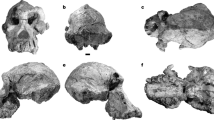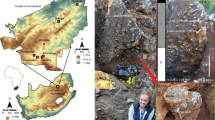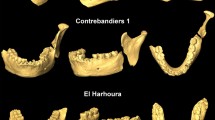Abstract
Since its discovery in 1972 (ref. 1), the cranium KNM-ER 1470 has been at the centre of the debate over the number of species of early Homo present in the early Pleistocene epoch2 of eastern Africa. KNM-ER 1470 stands out among other specimens attributed to early Homo because of its larger size, and its flat and subnasally orthognathic face with anteriorly placed maxillary zygomatic roots3. This singular morphology and the incomplete preservation of the fossil have led to different views as to whether KNM-ER 1470 can be accommodated within a single species of early Homo that is highly variable because of sexual, geographical and temporal factors4,5,6,7,8,9, or whether it provides evidence of species diversity marked by differences in cranial size and facial or masticatory adaptation3,10,11,12,13,14,15,16,17,18,19,20. Here we report on three newly discovered fossils, aged between 1.78 and 1.95 million years (Myr) old, that clarify the anatomy and taxonomic status of KNM-ER 1470. KNM-ER 62000, a well-preserved face of a late juvenile hominin, closely resembles KNM-ER 1470 but is notably smaller. It preserves previously unknown morphology, including moderately sized, mesiodistally long postcanine teeth. The nearly complete mandible KNM-ER 60000 and mandibular fragment KNM-ER 62003 have a dental arcade that is short anteroposteriorly and flat across the front, with small incisors; these features are consistent with the arcade morphology of KNM-ER 1470 and KNM-ER 62000. The new fossils confirm the presence of two contemporary species of early Homo, in addition to Homo erectus, in the early Pleistocene of eastern Africa.
This is a preview of subscription content, access via your institution
Access options
Subscribe to this journal
Receive 51 print issues and online access
$199.00 per year
only $3.90 per issue
Buy this article
- Purchase on Springer Link
- Instant access to full article PDF
Prices may be subject to local taxes which are calculated during checkout




Similar content being viewed by others
References
Leakey, R. E. F. Evidence of an advanced Plio-Pleistocene hominid from East Rudolf, Kenya. Nature 242, 447–450 (1973)
Gibbard, P. L. et al. Formal ratification of the quaternary system/period and the Pleistocene series/epoch with a base at 2.58 Ma. J. Quaternary Sci. 25, 96–102 (2010)
Wood, B. Koobi Fora Research Project Vol. 4: Hominid Cranial Remains (Clarendon, 1991)
Howell, F. C. in Evolution of African Mammals (eds Maglio, V. J. & Cooke, H. B. S. ) 154–248 (Harvard Univ. Press, 1978)
Johanson, D. C. et al. New partial skeleton of Homo habilis from Olduvai Gorge. Nature 327, 205–209 (1987)
Tobias, P. V. Olduvai Gorge Volume 4: The Skulls and Endocasts of Homo habilis. (Cambridge Univ. Press, 1991)
Suwa, G., White, T. D. & Howell, F. C. Mandibular post-canine dentition from the Shungura Formation, Ethiopia: c rown morphology, taxonomic allocation, and Plio-Pleistocene hominid evolution. Am. J. Phys. Anthropol. 101, 247–282 (1996)
Miller, J. M. Craniofacial variation in Homo habilis: an analysis of the evidence for multiple species. Am. J. Phys. Anthropol. 112, 103–128 (2000)
Suwa, G. et al. Early Pleistocene Homo erectus fossils from Konso, southern Ethiopia. Anthropol. Sci. 115, 133–151 (2007)
Leakey, R. E. F. Further evidence of Lower Pleistocene hominids from East Rudolf, North Kenya, 1973. Nature 248, 653–656 (1974)
Wood, B. A. in Ancestors: The Hard Evidence (ed. Delson, E. ) 206–214 (Alan R. Liss, 1985)
Stringer, C. B. in Major Topics in Primate and Human Evolution (eds Wood, B., Martin, L. & Andrews, P. ) 266–294 (Cambridge Univ. Press, 1986)
Lieberman, D. E., Pilbeam, D. R. & Wood, B. A. A probabilistic approach to the problem of sexual dimorphism in Homo habilis: A comparison of KNM-ER 1470 and KNM-ER 1813. J. Hum. Evol. 17, 503–511 (1988)
Groves, C. P. A Theory of Human and Primate Evolution (Clarendon, 1989)
Wood, B. Origin and evolution of the genus Homo . Nature 355, 783–790 (1992)
Rightmire, G. P. Variation among early Homo crania from Olduvai Gorge and the Koobi Fora region. Am. J. Phys. Anthropol. 90, 1–33 (1993)
Kramer, A., Donnelly, S. M., Kidder, J. H., Ousley, S. D. & Olah, S. M. Craniometric variation in large-bodied hominids: testing the single-species hypothesis for Homo habilis . J. Hum. Evol. 29, 443–462 (1995)
Kimbel, W. H., Johanson, D. C. & Rak, Y. Systematic assessment of a maxilla of Homo from Hadar, Ethiopia. Am. J. Phys. Anthropol. 103, 235–262 (1997)
Blumenschine, R. J. et al. Late Pliocene Homo and hominid land use from western Olduvai Gorge, Tanzania. Science 299, 1217–1221 (2003)
Clarke, R. J. A Homo habilis maxilla and other newly-discovered hominid fossils from Olduvai Gorge, Tanzania. J. Hum. Evol. http://dx.doi.org/10.1016/j.jhevol.2011.11.007 (4 May 2012)
Dean, M. C. & Smith, B. H. in The First Humans: Origin of the Genus Homo (eds Grine, F. E., Fleagle, J. G. & Leakey, R. E. ) 101–120 (Springer, 2009)
Bromage, T. G., Schrenk, F. & Zonneveld, F. W. Paleoanthropology of the Malawi Rift: An early hominid mandible from the Chiwondo Beds, northern Malawi. J. Hum. Evol. 28, 71–108 (1995)
Wood, B. ‘Homo rudolfensis’ Alexeev, 1986 – fact or phantom? J. Hum. Evol. 36, 115–118 (1999)
Brown, F. H. & Feibel, C. S. Revision of lithostratigraphic nomenclature in the Koobi Fora region, Kenya. J. Geol. Soc. Lond. 143, 297–310 (1986)
McDougall, I. & Brown, F. H. Precise 40Ar/39Ar geochronology for the upper Koobi Fora Formation, Turkana Basin, northern Kenya. J. Geol. Soc. Lond. 163, 205–220 (2006)
Lourens, L., Hilgen, F., Shackleton, N. J., Laskar, J. & Wilson, D. in A Geologic Time Scale (eds Gradstein, F., Ogg, J. & Smith, A. ) 409–440 (Cambridge Univ. Press, 2004)
Braun, D. R. et al. Early hominin diet included diverse terrestrial and aquatic animals 1.95 Ma in East Turkana, Kenya. Proc. Natl Acad. Sci. USA 107, 10002–10007 (2010)
Joordens, J. C. A. et al. An astronomically-tuned climate framework for hominins in the Turkana Basin. Earth Planet. Sci. Lett. 307, 1–8 (2011)
Brock, A., Isaac, G. & Ll Paleomagnetic stratigraphy and chronology of hominid-bearing sediments east of Lake Rudolf, Kenya. Nature 247, 344–348 (1974)
McDougall, I. et al. New single crystal 40Ar/39Ar ages improve time scale for deposition of the Omo Group, Omo–Turkana Basin, East Africa. J. Geol. Soc. Lond. 169, 213–226 (2012)
Acknowledgements
We thank the Governments of Kenya and Tanzania for permission to carry out this research, the Kenya Wildlife Service for permission to work in the Sibiloi National Park, the National Museums of Kenya and the National Museum of Tanzania for access to specimens in their care, and the Turkana Basin Institute for support. The National Geographic Society, the Leakey Foundation and the Max Planck Society funded fieldwork or laboratory studies. Many people helped us with this research, including N. Adamali, R. Blumenschine, C. Boesch, F. Brown, P. Gunz, J. J. Hublin, W. Kimbel, K. Kupczik, R. Leakey, C. Lepre, D. Lieberman, P. Msemwa, R. Odoyo, R. Quinn, P. Rightmire, L. Schroeder, U. Schwarz, M. Skinner, H. Temming, A. Winzer and B. Wood. Curatorial assistance was given by A. Kweka, F. Manthi, E. Mbua, M. Muungu and J. Thiringi. KNM-ER 60000 was discovered by C. Nyete, KNM-ER 62000 by D. Elgite and KNM-ER 62003 by R. Moru. We particularly thank the Koobi Fora Research Project field crew: A. Aike, S. Aila, D. Elgite, M. Kirinya, D. Gidole, O. Kyalo, A. Longaye, A. Lawri, E. Linga, J. Lonyericho, S. Lomeiku, D. Muema, A. Moru, R. Moru, S. Muge, C. Nyete, L. Nzuve, H. Sale and A. Sharamo whose fieldwork led to the discovery of these specimens, and camp managers J. Mutuku and T. Ngundo. H. Churcher, J. Coreth, A. Hammond, J. LaCarrubba, F. Kirera, C. Lepre, M. Noback, R. Quinn, M. Skinner, I. Wallace and S. Wright participated in one or more of the 2007, 2008 or 2009 field expeditions when these specimens were discovered. We are grateful to F. and J. Pinto, W. Philips, M. Hettwer, P. Sylvester, H. Buchi, N. Seligman, E. von Simpson, J. Doerr and B. and J. Chelberg for their financial support of this fieldwork.
Author information
Authors and Affiliations
Contributions
Author Contributions M.G.L. and L.N.L. directed the field research, in which C.S.F. and F.S. participated. C.K. and F.S. prepared the hominin fossils, F.S. and M.C.D. made the virtual reconstructions, and C.S.F. studied the geological context. M.G.L., F.S., M.C.D., S.C.A. and L.N.L. made comparative observations and carried out analyses. F.S. took the lead in writing the paper, and S.C.A., M.C.D. and C.S.F. contributed.
Corresponding authors
Ethics declarations
Competing interests
The authors declare no competing financial interests.
Supplementary information
Supplementary Information
This file contains Supplementary Text, Supplementary Tables and Figures and Supplementary References (see Supplementary Contents for details). (PDF 2381 kb)
Rights and permissions
About this article
Cite this article
Leakey, M., Spoor, F., Dean, M. et al. New fossils from Koobi Fora in northern Kenya confirm taxonomic diversity in early Homo. Nature 488, 201–204 (2012). https://doi.org/10.1038/nature11322
Received:
Accepted:
Published:
Issue Date:
DOI: https://doi.org/10.1038/nature11322
This article is cited by
-
Calcium isotopic ecology of Turkana Basin hominins
Nature Communications (2020)
-
A genotype:phenotype approach to testing taxonomic hypotheses in hominids
The Science of Nature (2020)
Comments
By submitting a comment you agree to abide by our Terms and Community Guidelines. If you find something abusive or that does not comply with our terms or guidelines please flag it as inappropriate.



